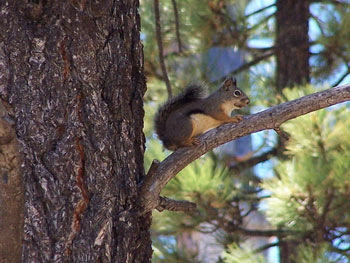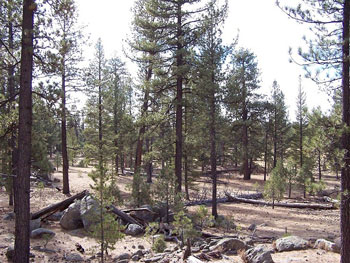CRL: Conservation Projects - Climate Change
Can red squirrel middens influence species diversity?
-
Time Period: August 2010-Present
-
Student: Erin Posthumus
-
Location: Mt. Graham, AZ, U.S.A.
-
 Red squirrels create structures, called middens, that concentrate food resources and create structural complexity in the forest, and some studies have found certain wildlife species to be associated with these middens. What is unclear is which characteristics of these middens attract species. My research will attempt to show which midden characteristics are most valuable to species diversity, which will have implications for forest management practices. My study will also shed light on the importance of larderhoarding animals to species diversity.
Red squirrels create structures, called middens, that concentrate food resources and create structural complexity in the forest, and some studies have found certain wildlife species to be associated with these middens. What is unclear is which characteristics of these middens attract species. My research will attempt to show which midden characteristics are most valuable to species diversity, which will have implications for forest management practices. My study will also shed light on the importance of larderhoarding animals to species diversity. -
Major Questions: Does species diversity differ at occupied middens, unoccupied middens and random locations? What characteristics of middens (i.e. vegetation features, food resources, and midden structure) affect species diversity? What is the importance of midden microclimate in explaining diversity?
-
Major Findings: Research in Progress
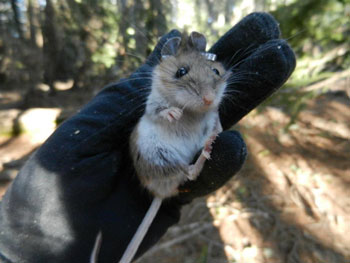
Project Details (click to expand/reduce)
Proximate cues and ultimate consequences for natal dispersal and settlement in an altered forest landscape: influence of experience, behavior, and habitat
-
Time Period: May 2010 - Present
-
Student: Melissa Merrick
-
Location: The Pinaleño Mountains, AZ, U.S.A.
-
 Major Questions: I am interested in factors influencing animal movements and habitat selection in the face of landscape alteration and fragmentation. Movement via natal dispersal is an important ecological mechanism contributing to gene flow, population structure and population dynamics, and guards populations against local extinction. Natal dispersal includes three stages: emigration, transience and exploration, and immigration and settlement. Whether an individual disperses, if it disperses how far it travels, how many places it explores, and where it settles is highly variable and is conditioned upon many factors including individual condition, local population density, sex ratios, resource abundance, experience in the natal area, habitat fragmentation, and individual behavior differences. Previous studies have shown that experience in the natal area provides individuals with important habitat cues which aid in deciding upon where to settle and also leads to variation in settlement patterns. Individual behavior differences may play a role in
Major Questions: I am interested in factors influencing animal movements and habitat selection in the face of landscape alteration and fragmentation. Movement via natal dispersal is an important ecological mechanism contributing to gene flow, population structure and population dynamics, and guards populations against local extinction. Natal dispersal includes three stages: emigration, transience and exploration, and immigration and settlement. Whether an individual disperses, if it disperses how far it travels, how many places it explores, and where it settles is highly variable and is conditioned upon many factors including individual condition, local population density, sex ratios, resource abundance, experience in the natal area, habitat fragmentation, and individual behavior differences. Previous studies have shown that experience in the natal area provides individuals with important habitat cues which aid in deciding upon where to settle and also leads to variation in settlement patterns. Individual behavior differences may play a role in dispersal distance and settlement decisions, including decision rules individuals employ when selecting a place to settle. Local density of conspecifics and associated sex ratios may influence male settlement decisions, whereas female settlement decisions may be more driven by available food resources. Increasingly, habitat fragmentation is also becoming an external factor influencing dispersal decisions and evidence suggests that small mammals dispersing through a fragmented habitat matrix tend to disperse further and explore less than individuals in contiguous habitat. I am testing several hypotheses related to natal habitat preference induction, behavioral phenotypes, decision rules, and habitat fragmentation and their influence on natal dispersal, especially transience and immigration.
dispersal distance and settlement decisions, including decision rules individuals employ when selecting a place to settle. Local density of conspecifics and associated sex ratios may influence male settlement decisions, whereas female settlement decisions may be more driven by available food resources. Increasingly, habitat fragmentation is also becoming an external factor influencing dispersal decisions and evidence suggests that small mammals dispersing through a fragmented habitat matrix tend to disperse further and explore less than individuals in contiguous habitat. I am testing several hypotheses related to natal habitat preference induction, behavioral phenotypes, decision rules, and habitat fragmentation and their influence on natal dispersal, especially transience and immigration. -
Some of my main research questions include: Do natal habitat cues (e.g. habitat structure, associated microclimate, and food availability) influence where settlement occurs? Do individual behavior differences (behavioral phenotypes) influence exploratory movements, decision rules, dispersal distance, and survival? Does forest fragmentation influence decision rules, settlement choices, and survivorship?
-
Major Findings To Date: Compared to non-peripheral red squirrel populations, dispersal in MGRS is sex-biased and exploration movements and settlement distances are far greater. Individual behavior differences explain variation in dispersal distances - active, aggressive individuals tend to disperse longer distances compared to less active, docile individuals. Natal habitat structure may play a role in cueing dispersers in on locations in which to settle. Forest structure derived from remotely sensed LiDAR data (e.g. canopy cover, basal area of live trees) in an individual’s natal area is more similar to forest structure at an individual’s settlement location compared to random locations. Further analyses are underway.

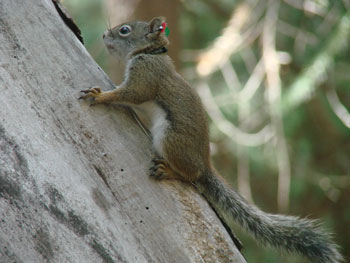
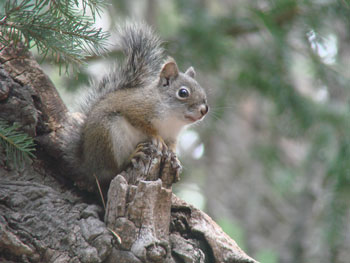
Project Details (click to expand/reduce)
What can endemics tell us? Space use and ecology of the endemic Arizona gray squirrel
-
Time period: August 2006 – December 2009
-
Student: Nichole Cudworth
-
Location: Huachuca Mountains, Arizona, USA
-
Research questions: How does mating strategy influence the space use of Arizona gray squirrels? At what scale are Arizona gray squirrels selecting nest sites?
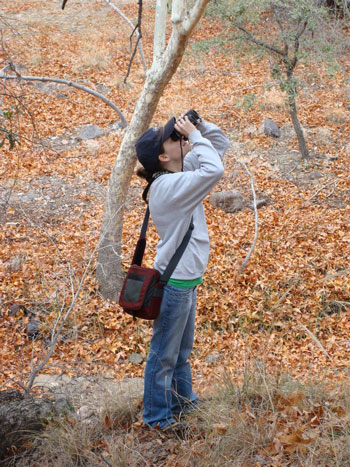
-
Major findings: Parental investment often differs between the sexes. For mammals, females invest heavily in reproduction, due to the high costs of pregnancy and lactation. Consequently, fitness of females is likely limited by the availability of food. Fitness of males, however, is more likely limited by the availability of mates. We investigated how these
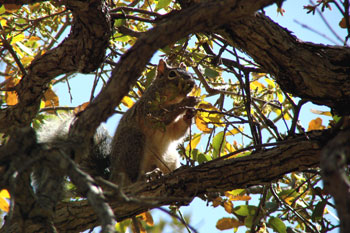 limiting factors would be predicted to influence the space use of Arizona gray squirrels. Arizona gray squirrels do not defend territories, and a female will only enter estrus for one day throughout the breeding season, thereby significantly reducing mating opportunities for males. We found that home ranges of Arizona gray squirrels are large (59 ha) and vary between sexes and seasons. Males had larger home ranges than females overall, and males increased home-range sizes during the breeding season, when males were traveling greater distances to locate receptive females. Females, however, maintained relatively constant home-range sizes throughout the year, although these home ranges were still large compared to other, closely related species, suggesting a system in which food availability is likely patchy and variable.
limiting factors would be predicted to influence the space use of Arizona gray squirrels. Arizona gray squirrels do not defend territories, and a female will only enter estrus for one day throughout the breeding season, thereby significantly reducing mating opportunities for males. We found that home ranges of Arizona gray squirrels are large (59 ha) and vary between sexes and seasons. Males had larger home ranges than females overall, and males increased home-range sizes during the breeding season, when males were traveling greater distances to locate receptive females. Females, however, maintained relatively constant home-range sizes throughout the year, although these home ranges were still large compared to other, closely related species, suggesting a system in which food availability is likely patchy and variable. -
Tree squirrels are highly dependent upon nests to provide a place to rest, raise young, avoid predators, and escape inclement weather. However, the scale at which nest-site selection has been analyzed has not been consistent, despite the obvious management implications when designing habitat plans. Arizona gray squirrels use leaf nests, or dreys, extensively throughout the year. We evaluated nest-site selection at 4 spatial scales: forest-type, nest-site, nest-tree, and within-canopy placement. Arizona gray squirrels select nesting locations within all spatial scales, although the benefits provided within these spatial scales likely varies, including providing access to food and water, cover from predators, travel routes to and from nest trees, thermal protection, and stable nesting structures. Riparian areas and the availability of Arizona sycamores (Platanus wrighti) for nest sites were especially important, emphasizing the need to protect these unique forest types in the mountains of the southwestern United States.
Project Details (click to expand/reduce)
Ecology of the endemic Mearns’s squirrel (Tamiasciurus mearnsi) in Baja California, Mexico
-
Time Period: August 2004 – May 2008
-
Students: Nicolas Ramos-Lara
-
Location: Sierra de San Pedro Mártir, Baja California, Mexico
-
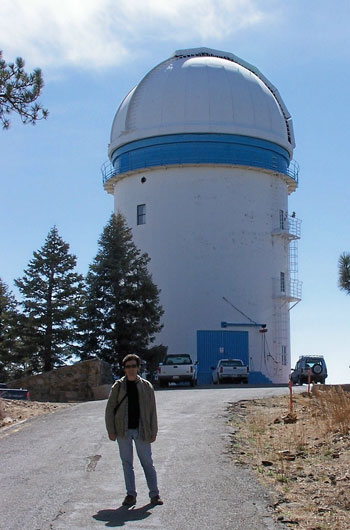 Major Questions: 1. What is the current situation of the arboreal squirrels of Mexico (review chapter)
2. Do Mearns’s squirrels have specific habitat requirements for nesting?
3. Do home-range dynamics and habitat use of Mearns’s squirrels differ from other congeners?
4. Do life-history and behavioral tactics of Mearns’s squirrels differ from other congeners?
Major Questions: 1. What is the current situation of the arboreal squirrels of Mexico (review chapter)
2. Do Mearns’s squirrels have specific habitat requirements for nesting?
3. Do home-range dynamics and habitat use of Mearns’s squirrels differ from other congeners?
4. Do life-history and behavioral tactics of Mearns’s squirrels differ from other congeners? -
Major Findings: 1. In Mexico, there are 14 recognized species of arboreal squirrels of which four are endemic, with the states of Chiapas and San Luis Potosi possessing the greatest diversity. 2. Presently, all species are listed under some category of risk by IUCN, seven by Mexico’s SEMARNAT, and only one by CITES. 3. Our literature survey yielded 37 publications revealing that a dearth of scientific information still exists on the arboreal squirrels of Mexico. 4. States with a greater diversity of arboreal squirrels also have higher annual wood productions, which may pose a serious threat to their persistence. 5. Mearns’s squirrels rely primarily on tree cavities for nests, with nest tree species, nest tree condition, nest tree size (DBH), canopy cover, and occurrence of white firs (Abies concolor) as important characteristics of the habitat for nesting. 6. Without larderhoards (middens), home-range dynamics of Mearns’s squirrels are similar to nonterritorial squirrels of the genus Sciurus, suggesting that middens played an important role in the evolution of territoriality in Tamiasciurus. 7. Using satellite imagery, I found that remote areas in the Sierra de San Pedro Mártir appear to have suitable habitat for the species. 8. Survival of adult Mearns’s squirrels was influenced by sex and body mass. 9. Mearns’s squirrels are heavier and apparently also larger than other congeners, possibly in part as an adaptation to feed on large pine cones (Pinus). 10. Interyear variation in weather and food supply strongly influenced fitness-related traits and behavior of Mearns’s squirrels.
